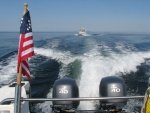hardee":9t1bri54 said:
I didn't know that there is a difference between a prop and a "twin prop". I thought they were propped for the size of motor (hp) and the max RPM attained at wide open throttle (WOT). Can't really see how my twin 40's could be propped for a single, or in the reprop process, there was nothing mentioned about "are this running as a single on the boat or are they working as one of a pair of twins".
I'm not a pro, but the way I understand propping motors, there would be a difference. I may not be able to explain it correctly (or may not even be correct), but here is what I believe:
Any engine has a specified WOT RPM. If you can attain that RPM at WOT, then by definition you are running the engine at levels that will not "lug" the engine (which is bad for it). Instead you are running at a certain percentage of the available horsepower (think about running your car at 30 mph in 5th gear vs. doing the same in 2nd gear; I think running a twin at high speed alone on a "twin" prop would be more like the former).
If you are pushing a light boat (or have a large engine for the boat size), then you would use "X" prop to power it (determined by going to WOT and figuring out which prop gets you to the mfgr. stated top RPM). If you are pushing a heavy boat (or have a small engine for the boat size), then a different prop would get you to that sweet spot. By definition, the same prop would not really do it for both extremes.
A "small" twin (small because it is only half of your planned horsepower) would actually be propped as half of a team. That is, the prop is only able to turn the engine up to the proper RPM at WOT
if it is operating in tandem with its "other half." If it's operating alone, but with the prop that makes it work properly as a set of twins, you would not be able to reach the proper RPM at WOT, and would thus be lugging the engine/running inefficiently. My guess is that if you take your boat out and run both twins together, you will get your mfgr-specified WOT at top speed, but that if you try the same thing with one twin alone, you won't. Probably both engines were run together to determine which props would work best for your setup.
OTOH, if you were propping the boat planning to run with a single 40 or 50 hp engine, I think you would choose a different prop (because you would be testing for the correct prop by running up to WOT with just the one engine, and going for the correct RPM that way). You would not get the same top speed (because, 40 hp can't do as much as the 80 hp you have with twin 40's), but you would probably get a higher speed, and more importantly, not be lugging the engine.
So my guess is that if one were going to use a single "twin" to get home in "any weather/tide/current condition,' that you might want to change to a "single" prop. Because I think (but don't know for sure) that if lugging the engine you would also not be getting the best power out of it, which you might well need in bad conditions (you would also be lugging, but if it's an emergency you probably would not "care" about hurting the engine).
Okay, now the people who really know can come in and point out where I'm mistaken (please do!).
Sunbeam :hot

